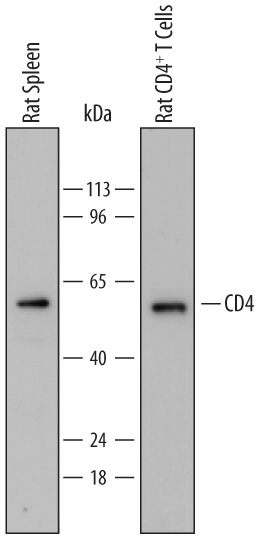Rat CD4 Antibody Summary
Lys28-Thr394
Accession # P05540
Applications
Please Note: Optimal dilutions should be determined by each laboratory for each application. General Protocols are available in the Technical Information section on our website.
Scientific Data
 View Larger
View Larger
Detection of Rat CD4 by Western Blot. Western blot shows lysates of rat spleen tissue and rat CD4+T Cells. PVDF membrane was probed with 0.2 µg/mL of Mouse Anti-Rat CD4 Monoclonal Antibody (Catalog # MAB6439) followed by HRP-conjugated Anti-Mouse IgG Secondary Antibody (Catalog # HAF018). A specific band was detected for CD4 at approximately 55 kDa (as indicated). This experiment was conducted under reducing conditions and using Immunoblot Buffer Group 1.
Reconstitution Calculator
Preparation and Storage
- 12 months from date of receipt, -20 to -70 °C as supplied.
- 1 month, 2 to 8 °C under sterile conditions after reconstitution.
- 6 months, -20 to -70 °C under sterile conditions after reconstitution.
Background: CD4
CD4, also known as L3T4, T4, and W3/25, is an approximately 55 kDa type I transmembrane glycoprotein that is expressed predominantly on thymocytes and a subset of mature T lymphocytes. It is a standard phenotype marker for the identification of T cell populations (1). Mature rat CD4 consists of a 367 amino acid (aa) extracellular region containing four immunoglobulin-like domains, a 23 aa transmembrane segment, and a 40 aa cytoplasmic domain (2). Within the ECD, rat CD4 shares 52% and 73% aa sequence identity with human and mouse CD4, respectively. CD4 is expressed along with CD8 on double positive T cells during their development in the thymus. Either CD4 or CD8 expression is then lost, giving rise to single positive (SP) CD4+ or CD8+ mature T cells (3). CD4+ SP cells, also known as T helper cells, further differentiate into multiple subsets of CD4+ cells including Th1, Th2, Th17, Tfh, and Treg cells which regulate humoral and cellular immunity (4). CD4 is re‑expressed on circulating CD8+ T cells upon activation and contributes to their cytotoxic effector activity (5). In the rat, CD4 is additionally expressed on macrophages and selected subsets of dendritic cells (6, 7). Similar CD4 distribution between species cannot be assumed as demonstrated by its presence on macrophages in human and rat but not in mouse (6). CD4 binds directly to MHC class II molecules on antigen presenting cells (8). This interaction contributes to the formation of the immunological synapse which is focused around the TCR-MHC class II-antigenic peptide interaction (1, 9). Palmitoylation of two cysteine residues in the cytoplasmic tail of CD4 promotes the localization of CD4 in lipid rafts and its ability to augment TCR signaling via activation of the tyrosine kinase Lck (10). CD4 also functions as a chemotactic receptor for IL-16 and, in human, as a co‑receptor for the gp120 surface glycoprotein of HIV-1 (11‑14). CD4 associates with CD44 on the cell surface to potentiate CD44-mediated cell adhesion (15).
- Vignali, D.A.A. (2010) J. Immunol. 184:5933.
- Clark, S.J. et al. (1987) Proc. Natl. Acad. Sci. 84:1649.
- Alarcon, B. and H.M. van Santen (2010) Sci. Signal. 3:pe11.
- Wan, Y.Y. and R.A. Flavell (2009) Mol. Cell Biol. 1:20.
- Kitchen, S.G. et al. (2005) Proc. Natl. Acad. Sci. 102:3794.
- Crocker, P.R. et al. (1987) J. Exp. Med. 166:613.
- Liu, L. et al. (1998) J. Immunol. 161:1146.
- Doyle, C. and J.L. Strominger (1987) Nature 330:256.
- Huppa, J.B. et al. (2010) Nature 463:963.
- Fragoso, R. et al. (2003) J. Immunol. 170:913.
- Cruikshank, W.W. et al. (1994) Proc. Natl. Acad. Sci. 91:5109.
- Klatzmann, D. et al. (1984) Nature 312:767.
- Dagleish, A.G. et al. (1984) Nature 312:763.
- Biswas, P. et al. (2003) Blood 101:4452.
- Umberto D. et al. (1999) International Immunology 11:1085.
Product Datasheets
Citation for Rat CD4 Antibody
R&D Systems personnel manually curate a database that contains references using R&D Systems products. The data collected includes not only links to publications in PubMed, but also provides information about sample types, species, and experimental conditions.
1 Citation: Showing 1 - 1
-
Oncolytic activity of HF10 in head and neck squamous cell carcinomas
Authors: S Esaki, F Goshima, H Ozaki, G Takano, Y Hatano, D Kawakita, K Ijichi, T Watanabe, Y Sato, T Murata, H Iwata, Y Shibamoto, S Murakami, Y Nishiyama, H Kimura
Cancer Gene Ther., 2019-09-03;0(0):.
Species: Mouse
Sample Types: Whole Tissue
Applications: IHC-P
FAQs
No product specific FAQs exist for this product, however you may
View all Antibody FAQsReviews for Rat CD4 Antibody
There are currently no reviews for this product. Be the first to review Rat CD4 Antibody and earn rewards!
Have you used Rat CD4 Antibody?
Submit a review and receive an Amazon gift card.
$25/€18/£15/$25CAN/¥75 Yuan/¥2500 Yen for a review with an image
$10/€7/£6/$10 CAD/¥70 Yuan/¥1110 Yen for a review without an image







